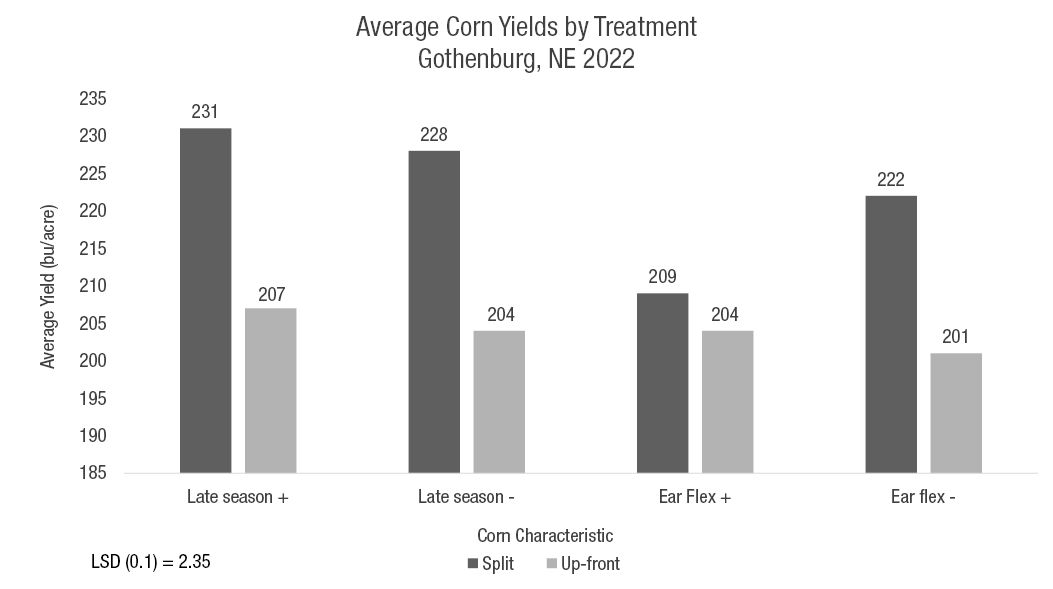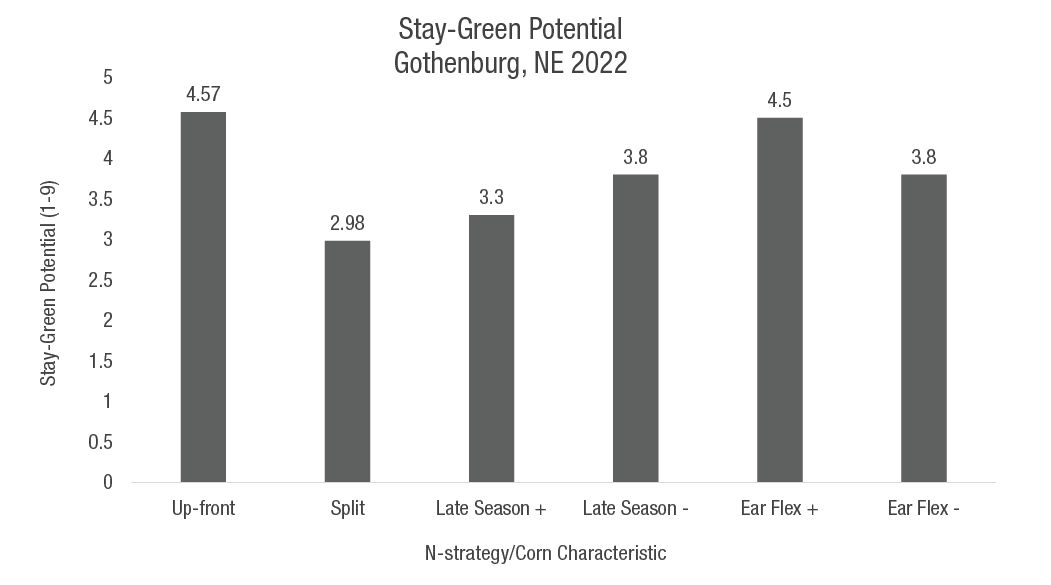The Effect of Nitrogen Application Strategy on Corn Yield
April 4, 2023
TO COMPARE YEARLY RESEARCH DATA, CLICK ON A TAB.
The Effect of Nitrogen Application Strategy on Corn Yield - 2022
TRIAL OBJECTIVE
- New corn products are introduced every year with an aim to improve the corn portfolio and farmer choice, resulting in a short time for farmers to become familiar with what nitrogen (N) strategy the corn product is most responsive to.
- Corn product characteristics such as late season plant health and ear flex require different management recommendations, and corn products can respond to different N application strategies depending on their characteristics.
- The objective of this study was to evaluate the effects of different N application strategies on the yield potential of corn products with different late season plant health and ear flex characteristics.
RESEARCH SITE DETAILS
| Location | Gothenburg, NE |
| Soil Type | Hord silt loam |
| Previous Crop |
Soybeans |
| Tillage Type |
Strip-tillage |
| Planting Date | 04/28/22 |
| Harvest Date | 10/09/22 |
| Potential Yield (bu/acre) |
250 |
| Seeding Rate (seeds/acre) |
36K |
- With a yield goal of 250 bu/acre, a total of 207 lbs of N/acre was applied either up-front or split applied throughout the growing season.
- The study design was a split plot with fertilizer as the whole plot and corn characteristics as the subplot with four replications.
- Fertility
- The study was strip-tilled on 4/14/2022 with a strip-till mix containing 29 lbs of N/acre, 60 lbs of Phosphorus (P)/acre, 25 lbs of Sulfur (S)/acre, and 0.25 lbs Zinc (Zn) /acre.
- Up-front N: 178 lbs of N/acre were applied with 360 Y-DROP® applicators on 6/17/2022.
- Split N: 58 lbs of N/acre were applied with 360 Y-DROP® applicators on 6/17/2022.
- The remaining 120 lbs of N/acre were applied through fertigation at 30 lbs/acre increments on 7/05, 7/20, 8/02, and 8/22.
- Characteristics and Relative Maturity (RM) of Corn Products
- Late season plant health defined by the stay-green rating of the corn product.
- High (+) – 105RM, 111RM (2), 112RM, 113RM, 114RM, and 115RM
- Low (-) – 101RM, 109RM (2), 110RM, 111RM (2), and 113RM
- Ear flex defined by advice from agronomists that indicate the ability to modify ear size in response to the environment.
- High (+)– 104RM, 107RM, 110RM, and 113RM (3)
- Low (-)– 106RM, 108RM, 109RM, 111RM, 112RM, and 114RM
- Late season plant health defined by the stay-green rating of the corn product.
- Fertility
- Weeds were controlled uniformly across the study. No additional insecticides or fungicides were included.
- Study was irrigated through a sub-surface drip irrigation system to meet the evapotranspiration demands of the crop and received 9.74 inches of rain through the growing season.
- Stay-green ratings were conducted in September to assess the late season vigor of corn plants on a scale of 1 to 9, with 1 being the greenest and 9 being the least green overall.
- Plots were harvested with a plot combine and total plot weight, percent moisture content, and test weight were collected.
UNDERSTANDING THE RESULTS
- In this study, corn treated with split-applied N throughout the growing season outyielded the up-front N corn by over 18 bu/acre (Figure 1).
- Average corn yield for the split-applied N was 222.38 bu/acre.
- Average corn yield for the up-front N was 203.82 bu/acre.

- Within the split application N treatment, the corn characteristics of strong late season plant health (late season +) yielded the highest and were significantly greater than the high ear flex (ear flex +) corn products.
- Similarly, within the up-front N treatment, the average corn yields from late season + corn products were the highest compared to the other corn characteristics, although not significantly higher.
- Overall, all corn characteristics within split-applied N, aside from ear flex +, had significantly greater average yields compared to the same corn characteristics within the up-front N treatment.
- A comparison of stay-green ratings within corn characteristics revealed that the late season + plants had a significantly lower average stay-green on a scale of 1 to 9 with 1 being the best (Figure 2).
- The yield advantage of the split application could be exaggerated by the abnormally dry growing season and the irrigation being from sub surface drip tape. There is the possibility that the up-front application did not have enough moisture for some of the N to move down into the root zone.


KEY LEARNINGS
- Split-applying N resulted in greater average corn yields compared to an up-front N strategy, regardless of corn product and associated corn characteristics.
- The goal of N management is to have the greatest amount of N available to the crop when nutrient demands are high and split-applying N throughout the growing season as the crop requires is a good management practice.
- Corn product characteristics affected average corn yields significantly, with the late season + products staying green later into the growing season resulting in higher average yields.
- Ear flex + corn products had lower average corn yields compared to the other corn characteristics, possibly due to drier than average conditions and a high seeding rate.
- Nitrogen management strategy and corn product characteristics can have significant effects on yield potential, with split-applied N and late season + corn products performing well under these conditions.
- In 2020 and 2021, corn products with higher late season plant health or stay-green ratings responded with increased yield to the fertigation strategy while corn products with late poor season plant health did not. The results in 2022 where all product classes responded to fertigation appears to be a result of the abnormally low in-season rainfall.
- Farmers should work with their local seeds sales team member to help identify the best adapted corn product for their production systems.
1213_219843